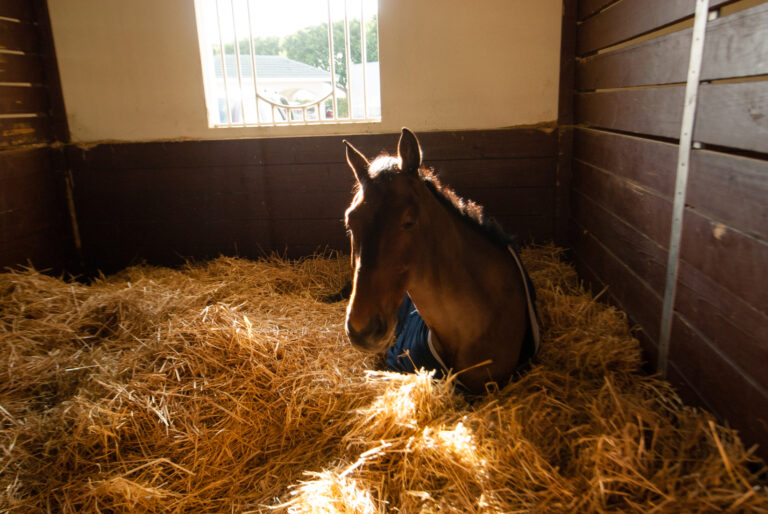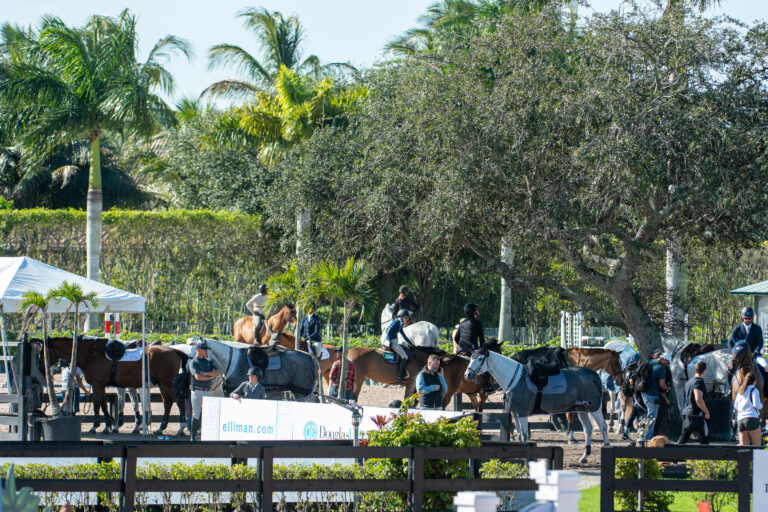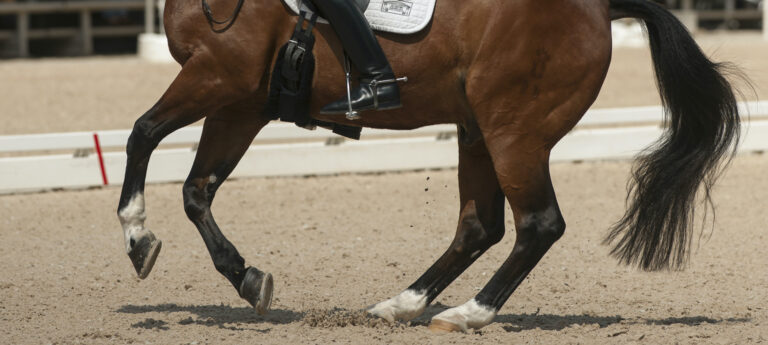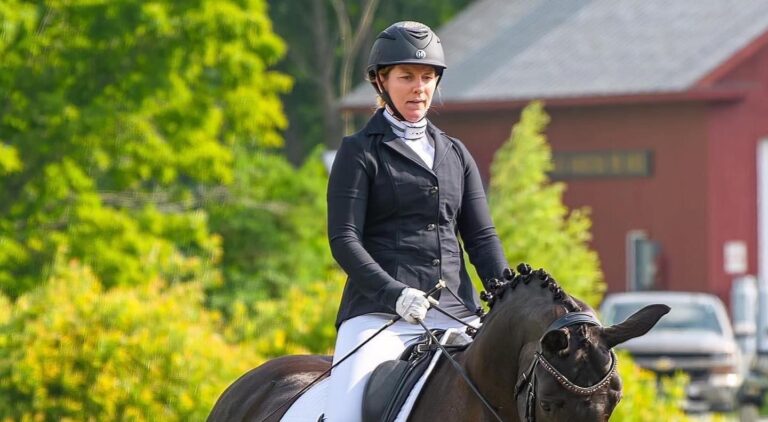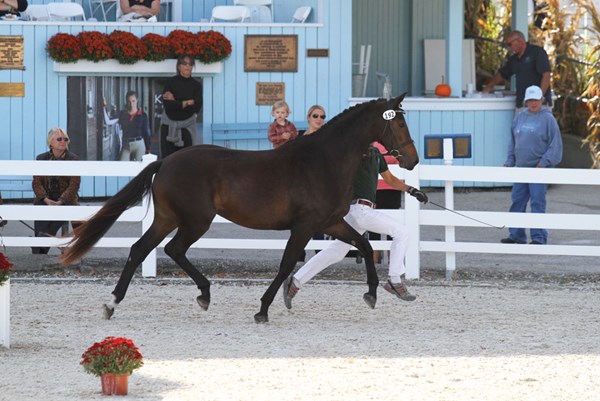
In the breed-show arena, judges are always searching for young, athletic performance horses and breeding stock that will serve the sport of dressage better and better. The discovery of new youngsters is exciting for the judges. Last month’s article focused primarily on the conformation portion of the class and this month we look at the horses in motion.
Skirting Danger to Find the Best Moments
Watching a dressage horse with beautiful movement takes my breath away. I want to have him, own him and ride him. A quality youngster shows us harmony and power in motion, and we must give every horse the chance to show himself as well as possible. Judges keep their eyes open all the time to catch a quick glimpse of the smallest moment of trot brilliance or a moment of relaxed walk so as to evaluate these qualities in the most favorable light.
Weanlings and yearlings have a hard time showing their potential because they are not yet secure or brave enough to express these qualities. Unless a trainer has spent significant time with the youngster in the halter, he may have a difficult time showing the horse in-hand. This preparation is hard, patient work, and I remember all the bruises I received working with these youngsters when they were flying like kites and bucking like broncos. Those sharp, little hooves hurt, and one cannot blame the young horse who only wants to express himself freely. Usually, the older generation of 2- and 3-year-olds is a little more civilized, but we can’t count on that either. The judges must be aware and read these youngsters before they explode so we can get out of the way fast.
Judging Movement
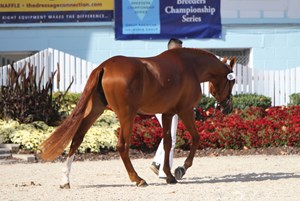
In assessing movement, we judge only the walk and trot, and the purity of these two gaits is the most important quality. As the horse walks away from the judge on the small triangle, she sees the view from behind: correctness of travel, hind-leg straightness, alignment of the steps, articulation of the joints and the swing of the tail in walk.
The middle line of the small triangle is where we see the profile of the horse in walk. Here we can look for the all-important, clear four-beat walk rhythm and freedom of the shoulders and haunches with ground-covering, marching regularity. The hind legs should reach forward and step well under the body. A walk that is too big can have a lateral tendency and problems with collection in the future. The lateral walk lacks the four-beat rhythm, and is a severe fault. A walk that barely steps into the foreprint is undesirable, as are uneven lengths of stride, dragging toes or excess lifting of the knee. Some of these faults are simply due to tension in the show ring, but we can judge only what we see. We look for articulation of the joints and elasticity. In addition to a pure rhythm, the horse should move through a supple back and the tail should be swinging. Those positive aspects receive high scores.
In judging the trot, the purity of the two-beat rhythm is, once again, of foremost importance. When trotting away from the judge, we notice the engagement and an active depart into the trot.
The middle line of the large triangle is, again, where we see the horse in profile, and we can look for the correct two-beat rhythm, regularity, articulation of all joints, freedom of the shoulders and haunches and a back that is elastic and swinging. We would also like to see some natural impulsion emanating from the thrusting hindquarters, an elastic, swinging back and engagement that creates a degree of suspension. Impulsion is a quality that isn’t present in the walk because there is no period of suspension. Depending on the horse’s age, we are also looking for some upward thrust so it is easier for him to develop roundness through the whole topline, giving the tendency to develop more pronounced self-carriage.
Factors that lower the score are: trailing haunches or the articulation of the hocks behind the buttock point; a flat, earth-bound trot lacking suspension; flipping toes; and paddling or traveling wide behind when more impulsion is added. As the horse comes back toward the judge, she has an opportunity to observe the front legs for correctness in their traveling mode.
The Scoring System
This year, the USDF score sheets changed to include four separate scores for conformation. This will allow the judges to be more specific in their comments.
Judges assign marks of 0 to 10, including the possibility of decimals. Then the scorer combines all the marks on the score sheet and turns it into a percentage. Marks of 4 and below are poor, 6 is average, 7 is fairly good and 8 or better means the horse has something special. When it’s decision time, the allowed decimal gives us a little more flexibility.
I want the breeders to know that I would much rather give high scores than low ones. The other judges agree with me on this point. Judges try to be kind and although they try to mention the strong points of each horse, they also have to be able to justify their scores, so there are times when the owners are disappointed. All owners think of their horses as special and they should. Each of these horses is going to be someone’s riding horse. Everyone who breeds, shows and handles horses in a breed show has my highest respect. Most sport-horse judges have shown young stock and they know what it takes.
General Impressions
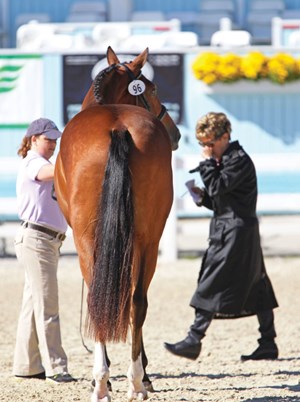
Every judge has developed a system to be able to take in the whole horse at a glance, and 10 percent of the score for all horses is based on this General Impression. However, the directives are slightly different in each class.
The breeding stock criteria for General Impression are:
• femininity for mares, masculinity for stallions
• development related to age
• harmony (relationship of conformation to movement)
• athleticism (strength and mobility) and condition
• character, presence and temperament.
The sport-horse prospect criteria for General Impression are:
• development related to age and
condition
• harmony (relationship of conformation to movement)
• athleticism (strength and mobility)
• character, presence and temperament necessary for training.
Is the Breed Show for Shoppers?
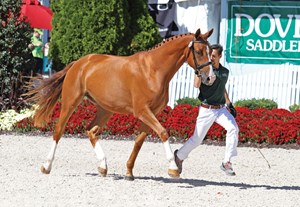
Breed shows can be a great place to shop for a new dressage prospect. But be aware of the following caveats: Excitement can give an average horse lift and suspension that are not typical of the natural gait of the horse. The atmosphere of the show can, to a degree, manufacture this suspension. Likewise, an experienced handler can make the average horse move better than average, and the judge must look through that when watching how the horse uses his body in motion. The horse must move well while being alert but also calm. I want to see the horse move naturally, not because he has been jazzed up to gain expression. Instead, the horse should come off the ground because of how he uses his hindquarters, which increases the likelihood that he will move well under saddle, too. It should be noted that the in-hand portion of the breed show asks only for walk and trot (I don’t mind when the horse breaks into canter so I can see a bit of it). Regardless, the canter, which is very important to the horse’s future, is not judged.
Horses who are gangly at the time of being presented can surprise us and often become super athletes after growing into themselves. We must always stay open-minded. I love to be surprised and admit to changing my mind about a horse.
While success at the breed show is a good sign, we do not know if each horse will enjoy being a riding horse. Some horses that show well in-hand fulfill their potential later on under saddle, and some do not. There is no guarantee, but following breed-show results can show us which bloodlines produce for the higher level of dressage. That is the reason for selective breeding with quality parents and grandparents with a record of producing competitive dressage horses. One can only choose a horse with potential and then give him quality training to maximize his abilities.
The rideable, willing, trainable horses with less quality are also wonderful equines for pleasure or for learning. Remember that not all riders have high expectations. There are many who could use the not-so-flamboyant gaits of an honest horse who is easy to sit.
The Role of the Handler
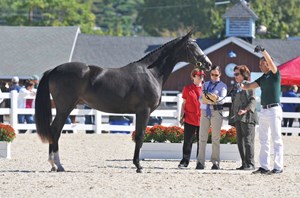
The handler plays an important role at the breed show. The judge can only evaluate what the horse shows by how he is presented. It takes tremendous effort to show a horse in-hand, and the handler can show off the horse to an advantage or disadvantage. The handler can even enhance the horse’s conformation by the way he presents him. He must know how to stand him up for the best view so the forehand does not look loaded, giving the horse a downhill appearance. We would like the horse to stand in an open stance, with front legs and hind legs slightly apart and not totally square. The proper stance reveals the horse’s shape and musculature. Judges assess what they see, not what they don’t see. Unfortunately, all of us have often written on the score sheet: “Can’t observe the horse’s gaits and judge his potential due to the inexperience of the handler. The gaits are being limited in their forward movement.”
The following are a few handler tips:
• Give the judge a chance to observe the horse by moving to the side when the judge is looking at the horse’s legs.
• Hold the reins or lead line properly. If it’s too tight, it causes the horse to push against the bit, and a pulling lead line makes the horse tense.
• Allow the horse to show his quality of gaits without inhibiting the movement. Limited gaits are not always the fault of the horse. It can be because of an inexperienced handler or perhaps the horse has not been trained enough to show his full potential. For instance, pulling the horse’s neck sideways can cause crookedness and irregularity, preventing him from showing his ability. The handler must be experienced enough to let the engine of the horse work and not be afraid of the horse’s forward activity.
• Present the horse in a manner that shows the breeder cares. If the mane is uneven or the legs have excess hair, especially around the fetlocks, it can obscure the conformation. With the exception of showing a breed known for its flowing mane and furry fetlocks, breeders should present their horses as neatly as possible.
It isn’t an easy job to show horses in-hand. Even skilled handlers have been kicked, bitten and trampled. My advice is to let professionals show the horse in-hand if you want to show off your horse’s full potential, especially if you are not skilled enough with the challenges of the show atmosphere.
To all breeders and handlers, I wish you luck. And keep your toes safe!
Lilo Fore is an FEI 5* judge. She has been a member of the ground jury for numerous U.S. Equestrian Team selection trials, the Pan American Games, the World Equestrian Games and the Olympic Games. She is also an FEI “C” judge for Para-Equestrian and a USEF “R” judge for sport horse. She was a founding member of the USDF Instructor Certification Program and is currently an examiner and the chair of the program. She has chaired or been a member of numerous committees for USDF and USEF and is a successful rider, trainer and coach. She owns and operates Sporthorse America, a dressage training facility located in Santa Rosa, California.
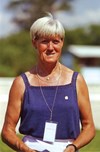
Age and Breed Considerations
At a breed show, we see horses of different ages and types. This can be a challenge for the judge because, in the case of breed differences, the movement of a warmbood is, for example, quite different from that of a Friesian. We don’t compare apples and oranges and decide which we prefer. Rather, the decision is based on the hard criteria for conformation (as seen in last month’s article) and for movement. The judge has to be careful and assess each horse in the same way for his potential as a dressage sport horse regardless of breed or type.
The same is true for age differences. Horses born in January will be in different developmental stages from the ones born in June. Knowing the horse’s age can make a difference. I always ask the handler about the age of the horse so I can be fair in my assessment. For example, the youngster born early will be more mature looking, while the one born later may be too high behind, which makes his hind legs look very straight, lacking angle in the joints, and his neck might look ewe-shaped.
Young horses grow in spurts, and a youngster in the growing-up phase can look somewhat awkward standing in front of us. Coming up with an opinion can be quite difficult until the horse moves. Then they sometimes surprise the judges. Even in the awkward stage, a quality youngster can show some of his potential. The weanlings and yearlings might not yet be relaxed in the halter. They sometimes struggle against the restraint of the halter and don’t always show their best in-hand. The judges have to be very attentive and keep looking for the special moments they give us.


